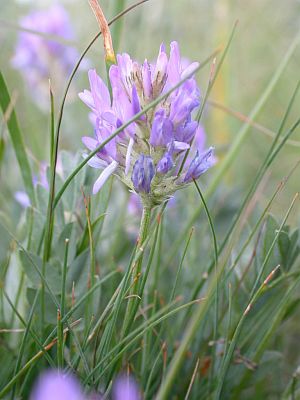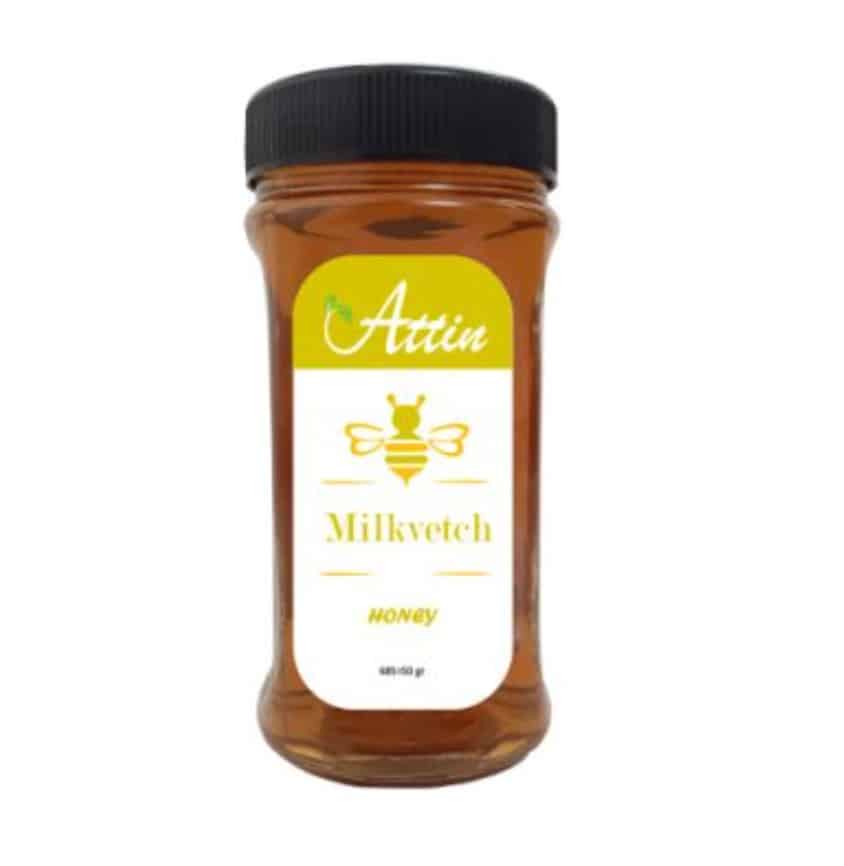Chinese milkvetch honey is a rare honey, coming mostly from China, Iran or North America, from the species Astragalus adsurges or Astragalus sinicus Linn. It’s a rather common honey, light yellow and with a plain taste. However, with many health benefits.
Milkvetch characteristics
Chinese milkvetch, often written milk-vetch or milk vetch, belongs to the large genus Astragalus, the largest genus of vascular plants in the world, that comprises an estimated number of 2900 annual and perennial herbs and small shrubs. They all like semi-arid and arid habitats, with a few species that select humid habitats (e.g. A. glycyphyllos L.),
The genus is native to temperate regions of the Northern Hemisphere. Astragalus L. is species. The members of this genus have a broad spectrum of uses (e.g. medicine, food, fodder, fuel, ornamental plants, etc.). However, there are species from North America, including Missouri milkvetch (A. missouriensis) and woolly loco (A. mollissimus), which are poisonous to livestock.

There are many reports on this genus from various regions of Iran, Turkey, India, Pakistan, China and American countries. Iran is known for its high diversity of astragalus, which comprises 850 species, of which 527 are endemics.
With its vast fields, China is also known for its multitude of astragalus species. There are several species found under the name Chinese milkvetch: Astragalus membranaceus, Astragalus adsurgens or Astragalus sinicus Linn (aka renge).
Other common names for astragalus species include milkvetch (most species), locoweed (in North America, poisonous) and goat’s-thorn (A. gummifer, A. tragacantha); prairie milkvetch (Astragalus adsurgens, or Astragalus laxmannii in Minnisota)., or Mongolian milk vetch aka huang zhi (Astragalus propinquus).
They are widely used as medicine, food, fodder, fuel and as ornamental plants in different ethnobotanical practices throughout the world.
What is milkvetch honey made of?
Not all species of astragalus make honey. Monofloral milkvetch honey is pretty rare, mostly because wherever astragalus grows, there is also a multitude of other flowers, and the resulted honey is always polifloral (aka meadow honey).
But in some parts of the world, such as north-east China, and Yunwu Mountains in north-west China, astragalus (Astragalus adsurgens) is the predominant plant that grows. It can reach up to five feet and it is especially used as fuel and silage for livestock. Beekeepers place their hives there to take advantage of the flowers.
Iran also produces monofloral milkvetch honey due to their multitude of astragalus species.
Honey is generally made from the variant Astragalus adsurgens, also known as Astragalus laxmannii, but online I could also find milkvetch honey from Astragalus sinicus Linn and Astragalus membranaceus.
Milkvetch honey has a typical yellow honey color and a very plain taste.
Milkvetch honey benefits for health
There are some studies showing the antioxidant and anti-inflammatory properties of milkvetch honey but there is still need for scientific studies to pinpoint the exact benefits of milkvetch honey. In their absence, we can trust that milkvetch honey brings the regular benefits any honey brings: anti-inflammatory, antioxidant, antibacterial, and immunity busting.
♦ In a 2023 study 37 Astragalus honey samples from 8 different regions from Turkey were investigated for the phenolic compositions and antioxidant, antimicrobial, anti-quorum sensing, anti-inflammatory and enzyme inhibitory. The samples showed moderate antimicrobial activity against Candida species, gram-negative and gram-positive bacteria while they showed high quorum sensing inhibition effects.
Chinese milk vetch has powerful antioxidant properties
♦ A 2018 study by Yuhong Zheng et al., analyzed 6 types of honey to evaluate its antioxidant potency. The results indicated that the f total antioxidant activity of the honey from different sources follows the following order: Chinese milk vetch honey > jujube honey > linden honey > locust honey > citrus honey > wattle honey.
Chinese milk vetch has antibacterial properties
♦ In a 2014 study, Azizollah Bakhtari, from the University of Connecticut, analyzed the Antibacterial Activity of Milk Vetch Flower Honey against Four Bacteria of Human Oral Flora: Streptococcus mutans, Lactobacillus casei, Lactobasillus rhamnosus and Lactobasillus plantarum.
He determined that the minimum inhibitory concentrations for honey against S. mutans, L. casei, L. rhamnosus and L. plantarum were 75, 75, 100 and 100 ppm, respectively.
“the reasonable antibacterial effect of milk vetch flower honey against mentioned bacteria species indicated that this type of honey could be used as a natural antibiotic, however, it needs more studies for finding its effective agents.”
Milk vetch honey is good for skin wounds
♦ In a 2013 study, Effects of three types of Japanese honey on full-thickness wound in mice, by Yukari Nakajima et al., Chinese milkvetch had better results on a 14 skin wound, compared to 2 types of honey, acacia and buckwheat honeys.
Do all honeys have powerful antioxidant properties?
Not quite. The antioxidant strength of honey depends on the source of the honey, season, environmental factors, and the process of honey production (M. Gauthier et al.,2016; H.E. Tahir et al., 2017).
What gives honey its antioxidant properties?
There are components in honey that give its antioxidant properties: flavonoids and phenolic acids, enzymes (glucose oxidase, catalase), ascorbic acid, Maillard reaction products, carotenoids, organic acids, amino acids and proteins.
Natural antioxidants in honey. Do we really need antioxidant supplements?
Why do we need antioxidants?
All natural antioxidants have a wide range of biological activities such as antibacterial, anti-inflammatory, anti-allergic, anti-thrombosis and vasodilation functions (P.M. Kuś et al., 2014; N.S. Ahmad st al., 2017).

Folclor claims this type of honey is used as a urinary tract disinfectant for kidney patients, for heart and liver conditions, and in the treatment of eye diseases.
A review from 2020 showed that various Astragalus species have great traditional uses in different ethnobotanical practices throughout the world. The two most frequently mentioned Astragalus treatments, were against urinary and respiratory diseases.
Where can I find milkvetch honey?
That’s quite a challenge. Online, I could find only 3 places: Alibaba, ecoagrolog.am (see picture) and shopee.com.my
Astragalus benefits in tradition around the world
There have been remarkable ethnobotanical and traditional applications of the genus Astragalus all over the planet. From its uses as an antifatigue, antistress (adaptogenic), antiaging, neuroprotective, and cognitive enhancer agent to sexual dysfunction and genital sickness.
However, the astragalus species differ; be careful when buying supplements. Radix Astragali, from the Chinese medicine, comes from Astragalus mongholicus, not from Astragalus sinicus.
♦ In the US, Idoho, Astragalus is known as Rattle Milkvetch (Astragalus amphioxys) due to its benefit in rattlesnake bites. The root is chewed by a medicine man before sucking upon the wound, and then the chewed root is applied to the bite. It is regionally called Chitdola awan ak’wa.
But in the US, there are other variants of Astragalus with other uses:
- A. crassicarpus (aka Groundplum milkvetch) is used:
– as tonic, anticonvulsive and anti-headache (root decoction)
– as snack- either eating the raw fruit or the raw, cooked, or pickled pods. - A. americanus (aka American milkvetch) is used for stomach pain and flu when the root is chewed.
- A. canadensis L (aka Canadian milkvetch) is used as analgesic – the root is eaten raw or boiled in blood to make broth.
♦ In Turkey astragalus genus is represented by 400 species in 62 sections (Adıgüzel et al., 2009). It is used for ulcer (A. lamarckii), Cardiac disorder (A. longifolius), Varicosis (A. noaeanus), Toothaches ( A. tmoleus Boiss), diabetes (root decoction) or as animal fodder.
♦ In Iran, it is used for as laxative, febrifuge, and digestive (A. brachycalyx), for colds (A. camptoceras), kidney stone, sedative, arthrodynia, carminative (A. crenatus). It is used for cough (A. effusus), for tightening the roots of teeth, cough, nutritious, kidney, stomach ache, chest infection, toothache (A. fasciculifolius). It is also used for back ache, bone ache, kidney ache, bone fracture, and diabetes, and to induce abortion (A. fischeri).
♦ In Italy, the roots and leaves of their common astragalus, A. glycyphyllos, are used for their refreshing, purifying, and diuretic properties. They were also used for kidney ailments, gout and rheumatism.
♦ In India, A. hamosus L., the decoction of the beans of A. hamosus L is used internally in nervous system disorders; liver, kidney, and spleen infections. The paste of the beans is massaged and applied externally on inflamed areas.
♦ In Russia Astragalus adsurgens is used as a diuretic for the treatment of oedema.
It seems that each country has a specific species of astragalus, and each tradition uses it to treat different conditions.
All the parts of the plant seem to possess medicinal benefits, but the root is considered the most potent.
Chinese milkvetch improves rice yield
It was shown in numerous studies that milk vetch (Astragalus sinicus L) is an organic fertilizer source that can partially replace chemical fertilizer without reducing yield.
♦ A 2022 study by Wei Yang, showed that Chinese milk vetch (Astragalus sinicus L.), has potential to replace or partly replace inorganic nitrogen (N) fertilizer. Chinees milk vetch is a well-established green manure for paddy soils, thus an important N source replacing chemical fertilizer in rice cropping systems in most Asian countries.
♦ The utilization of milk vetch can achieve the dual goals of soil fertilization and increased rice yield. In a 2023 study the results from two long-term field experiments showed that, compared with conventional fertilization, the application of different amounts of MV with a 20 % reduction of chemical fertilizer increased or maintained rice yield, enhanced the uptake and use efficiency of N, P, and K, and improved soil fertility.
*****************
References and further readings:
https://www.minnesotawildflowers.info/flower/prairie-milkvetch#:~:text=adsurgens%20is%20found%20in%20northern,similar%20to%20Ground%20Plum%20(A.
https://bookstore.ksre.ksu.edu/download/chinese-milkvetch_MF2612
pictures source wikimedia commons
